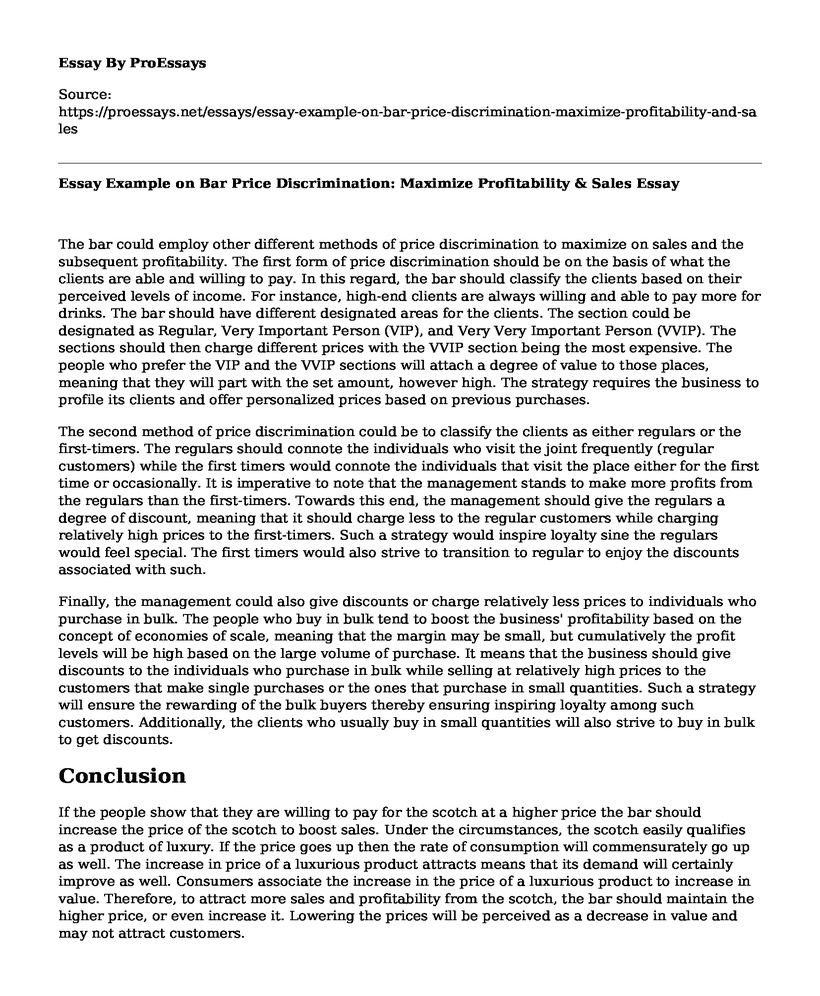The bar could employ other different methods of price discrimination to maximize on sales and the subsequent profitability. The first form of price discrimination should be on the basis of what the clients are able and willing to pay. In this regard, the bar should classify the clients based on their perceived levels of income. For instance, high-end clients are always willing and able to pay more for drinks. The bar should have different designated areas for the clients. The section could be designated as Regular, Very Important Person (VIP), and Very Very Important Person (VVIP). The sections should then charge different prices with the VVIP section being the most expensive. The people who prefer the VIP and the VVIP sections will attach a degree of value to those places, meaning that they will part with the set amount, however high. The strategy requires the business to profile its clients and offer personalized prices based on previous purchases.
The second method of price discrimination could be to classify the clients as either regulars or the first-timers. The regulars should connote the individuals who visit the joint frequently (regular customers) while the first timers would connote the individuals that visit the place either for the first time or occasionally. It is imperative to note that the management stands to make more profits from the regulars than the first-timers. Towards this end, the management should give the regulars a degree of discount, meaning that it should charge less to the regular customers while charging relatively high prices to the first-timers. Such a strategy would inspire loyalty sine the regulars would feel special. The first timers would also strive to transition to regular to enjoy the discounts associated with such.
Finally, the management could also give discounts or charge relatively less prices to individuals who purchase in bulk. The people who buy in bulk tend to boost the business' profitability based on the concept of economies of scale, meaning that the margin may be small, but cumulatively the profit levels will be high based on the large volume of purchase. It means that the business should give discounts to the individuals who purchase in bulk while selling at relatively high prices to the customers that make single purchases or the ones that purchase in small quantities. Such a strategy will ensure the rewarding of the bulk buyers thereby ensuring inspiring loyalty among such customers. Additionally, the clients who usually buy in small quantities will also strive to buy in bulk to get discounts.
Conclusion
If the people show that they are willing to pay for the scotch at a higher price the bar should increase the price of the scotch to boost sales. Under the circumstances, the scotch easily qualifies as a product of luxury. If the price goes up then the rate of consumption will commensurately go up as well. The increase in price of a luxurious product attracts means that its demand will certainly improve as well. Consumers associate the increase in the price of a luxurious product to increase in value. Therefore, to attract more sales and profitability from the scotch, the bar should maintain the higher price, or even increase it. Lowering the prices will be perceived as a decrease in value and may not attract customers.
Cite this page
Essay Example on Bar Price Discrimination: Maximize Profitability & Sales. (2022, Dec 27). Retrieved from https://proessays.net/essays/essay-example-on-bar-price-discrimination-maximize-profitability-and-sales
If you are the original author of this essay and no longer wish to have it published on the ProEssays website, please click below to request its removal:
- Antifeminism Essay Example
- Encountering Kali: Deconstructing Marginalization of Women in South Asia - Essay Sample
- Project Evaluators: Vital Role in Project Planning & Management - Essay Sample
- How Ombudsman Ensures Conflict Resolution in Organizations - Essay Sample
- Gang Affiliation & Delinquency: A Linked Reality - Essay Sample
- Essay Sample on Invictus: Uniting a Nation Through Leadership and Equality
- Navigating Colorblindness: Unveiling the Complexity of Identity and Inequality - Essay Sample







